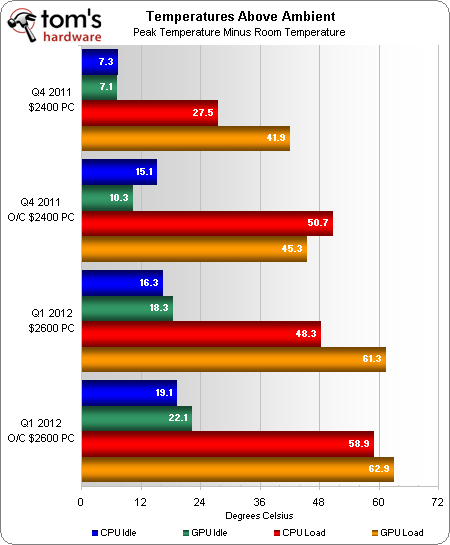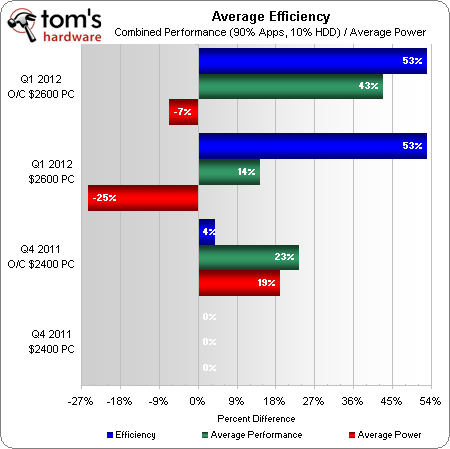System Builder Marathon, March 2012: $2600 Performance PC
Power, Heat, And Efficiency
Intel’s Sandy Bridge-E design is a power hog compared to the Sandy Bridge-based Core i7-2600K. On the other hand, Nvidia’s GeForce GTX 580 counteracts the efficiency of Intel's quad-core design from last quarter, sucking down a lot more power than the single GPU driving our new Radeon HD 7970. On average, today's $2600 build uses much less power than its $2400 predecessor.
Remember that total system power consumption is measured at the wall! With that in mind, our new configuration uses about half of the power supply’s rated capacity prior to overclocking. It’s because of this moderate draw that we see the potential for three-way CrossFireX.
Our desire to keep the $2600 PC at its quietest throughout testing compelled us to leave all of its fans in Automatic mode. Temperatures climbed, but noise was somewhat tolerable, even in the face of a full GPU load. All of our fans had at least 20% more capacity, which means that the system’s ability to cope with higher ambient temperatures would likely outlast our self-control. We'd get sick of the increased fan noise and throw this thing out the window long before it overheated.
Efficiency compares energy and work, so we compared average performance to average power consumption in its calculation. The standard-frequency $2400 PC sets the baseline, which is 100% in our performance chart.
Because nothing can be more than 100% efficient, we subtracted the 100% baseline from our calculations before charting our efficiency results. Though power consumption increases with voltage and frequency, similarly increased performance allows our new build to retain its 53% gain, even when it's overclocked.
Current page: Power, Heat, And Efficiency
Prev Page Benchmark Results: Productivity Next Page Does The CPU Gamble Pay Off?Get Tom's Hardware's best news and in-depth reviews, straight to your inbox.
-
llguitargr8 Just curious, did you guys purchase all these parts and right these articles before the GTX 680 was released? I really thought you guys would have gone with that, and if it wasn't because they weren't available at the time, then what makes the 7970 better in your opinion?Reply -
g-unit1111 Not sure if I agree with that choice of cooler but I definitely like the rest of the setup!Reply -
bystander llguitargr8Just curious, did you guys purchase all these parts and right these articles before the GTX 680 was released? I really thought you guys would have gone with that, and if it wasn't because they weren't available at the time, then what makes the 7970 better in your opinion?Almost all these build articles are based on purchases that took place 2 months ago. Even if they were to have bought these parts today, it would be hard to purchase a 680, as stock is a major issue.Reply -
esrever I like the build except the x79 adds like $500 extra that I see very little benefit from.Reply -
e56imfg Dang I need to win this one!! I'm so happy they balanced the CPU with the GPU this time around.Reply -
hmp_goose Good job: Working through the details of the CPU cooler like that is half the fun of this hobby. Great build.Reply -
theuniquegamer Good build . But there could be more improvement by replacing a $600 cpu and $320 mother board with a i7 2600k and a $200 z68 mother board . And also replacing the 7970($590) with 2x680 at 2x$500(from the money saved from cpu and motherboard and 7970). It may give better gaming result than this build.Reply





